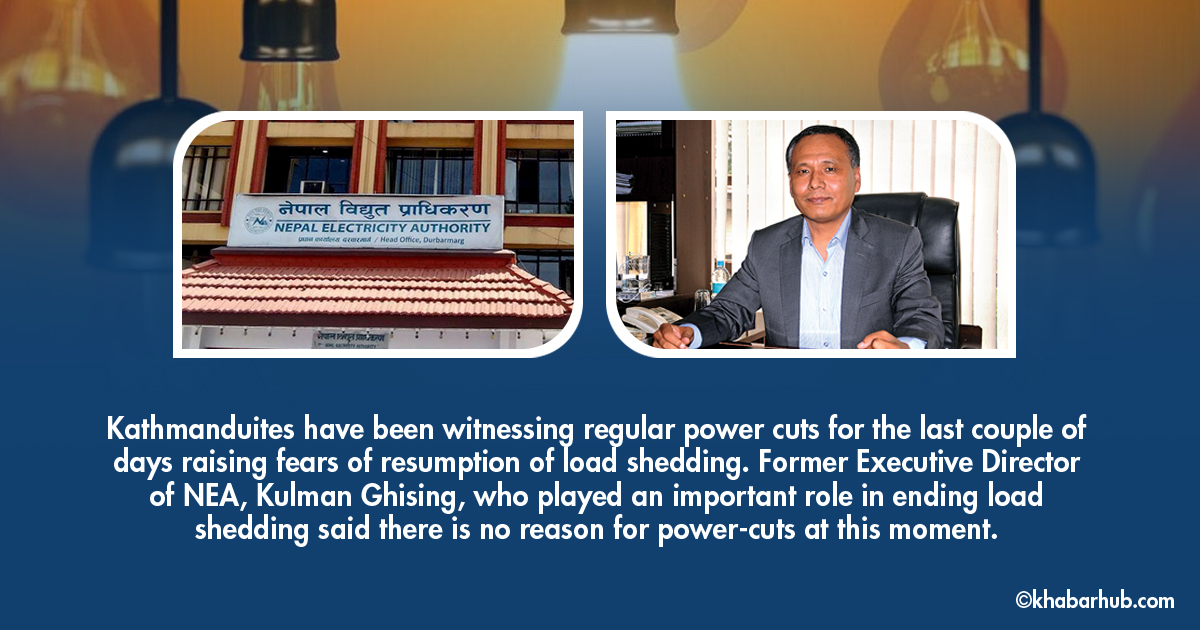KATHMANDU: The problem of a power outage for nearly 18 hours a day that had been like a poor fate of the people in the country was resolved immediately after Kulman Ghising was appointed as the Managing Director of Nepal Electricity Authority (NEA).
For some time now, frequent power cuts have started reminding the Nepalis of those dark days when Nepal witnessed massive power outages raising fear and suspicion over the possibility of load shedding hours yet again.
NEA’s latest notice about the regular power cut has made people suspicious of the motifs of the authority.
Kathmandu Valley, in particular, has been experiencing a power cut in one part or another for a couple of hours almost regularly. Some have started linking the power cut with the exit of Ghising.
Amidst suspicion and criticisms, the NEA has tried to make it clear to the people not to suspect on load shedding issue. However, irregularities in the power supply are the same.
Former MD Ghising also opines that there is no reason for load-shedding provided it is properly managed.
Ghising, meanwhile, thinks that the problem in the power supply is due to managerial weakness. According to him, the general public’s grievances over power outages should be addressed immediately.
According to him, the management should arrange for the proper management of load to avoid load-shedding.
“We should manage the chain of command from the bottom up,” Ghising said talking about the current power cuts, “Load management should also be carried out accordingly. Power supply alone does not mean no load shedding.”
Proper management of the transmission is also vital to avoid load shedding.
“We have to see if there is load in the substations during distribution,” Ghising shared the experience, “If the light goes out at 8 pm today, it has to be acted instantly. One should not wait until tomorrow for the customers have to pass the whole night without electricity. This is the problem now.”
“We have made it clear through a statement that there is no load-shedding at the moment. Some places have to be cut off for maintenance for a couple of hours,” Madan Timsina, the Deputy Executive Director of NEA said.
He added that the NEA is trying to address the concerns about the frequent power cut problems people started grumbling about.
According to Timsina, there is a daily demand of 1,470 MW electricity during peak hours and the supply is met as per the demand. The load is being managed by domestic production and imports from India.
“The demand has reached 1470 MW, we have also brought and supplied from India,” Timsina explained, “We have met the demand even by operating Kulekhani at the full capacity. There is no need for load shedding now.”
Ghising, meanwhile, thinks that the problem in the power supply is due to managerial weakness. According to him, the general public’s grievances over power outages should be addressed immediately.
“Public grievances should be addressed immediately, employees also have to be motivated, and there should be a proper man in the right place,” Ghising said ahead adding, “When the employees are transferred haphazardly, even they might not know the system, power pressure, among other issues.”
Former MD Ghising regards it important for the top leadership of NEA to be aware of all the projects in the country.
The top management should have an immediate response to any place. “If we took two or three hours to reach the place, it does not work,” he said.
If any power plants at the supply site are damaged, the leadership should know it in advance. Similarly, the hooking and theft of electricity should also be controlled.
He said that this is also the ‘peak time’ for electricity theft.
“When people get the stolen electricity or theft electricity, they are likely to use it excessively wasting the power needed for other places. This results in power cuts due to the inability to bear the load.” Ghising explained.
Ghising estimates that the leakage may be the reason for the current load shedding. He points out that management should also be agile as poor management may also result in an increase of load-shedding. Similarly, poor infrastructure might result in physical infrastructure.
Ghising reiterates that the NEA leadership should take initiative for load management.
The top management should have an immediate response to any place. “If we took two or three hours to reach the place, it does not work,” he said.
The management has a significant role in managing electricity consumption.
When load shedding occurs, everyone starts arranging for the power backups which adds further load.
According to Ghising, consumers should also be assured that there will be no load-shedding.








Comment